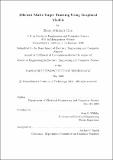| dc.contributor.advisor | Alan S. Willsky. | en_US |
| dc.contributor.author | Chen, Zhexu (Zhexu Michael) | en_US |
| dc.contributor.other | Massachusetts Institute of Technology. Dept. of Electrical Engineering and Computer Science. | en_US |
| dc.date.accessioned | 2009-06-25T20:36:37Z | |
| dc.date.available | 2009-06-25T20:36:37Z | |
| dc.date.copyright | 2008 | en_US |
| dc.date.issued | 2008 | en_US |
| dc.identifier.uri | http://hdl.handle.net/1721.1/45632 | |
| dc.description | Thesis (M. Eng.)--Massachusetts Institute of Technology, Dept. of Electrical Engineering and Computer Science, 2008. | en_US |
| dc.description | This electronic version was submitted by the student author. The certified thesis is available in the Institute Archives and Special Collections. | en_US |
| dc.description | Includes bibliographical references (p. 103-104). | en_US |
| dc.description.abstract | The objective of this thesis is to develop a new framework for Multi-Target Tracking (MTT) algorithms that are distinguished by the use of statistical machine learning techniques. MTT is a crucial problem for many important practical applications such as military surveillance. Despite being a well-studied research problem, MTT remains challenging, mostly because of the challenges of computational complexity faced by current algorithms. Taking a very di®erent approach from any existing MTT algorithms, we use the formalism of graphical models to model the MTT problem according to its probabilistic structure, and subsequently develop e±cient, approximate message passing algorithms to solve the MTT problem. Our modeling approach is able to take into account issues such as false alarms and missed detections. Although exact inference is intractable in graphs with a mix of both discrete and continuous random variables, such as the ones for MTT, our message passing algorithms utilize e±cient particle reduction techniques to make approximate inference tractable on these graphs. Experimental results show that our approach, while maintaining acceptable tracking quality, leads to linear running time complexity with respect to the duration of the tracking window. Moreover, our results demonstrate that, with the graphical model structure, our approach can easily handle special situations, such as out-of-sequence observations and track stitching. | en_US |
| dc.description.statementofresponsibility | by Zhexu (Michael) Chen. | en_US |
| dc.format.extent | 104 p. | en_US |
| dc.language.iso | eng | en_US |
| dc.publisher | Massachusetts Institute of Technology | en_US |
| dc.rights | M.I.T. theses are protected by
copyright. They may be viewed from this source for any purpose, but
reproduction or distribution in any format is prohibited without written
permission. See provided URL for inquiries about permission. | en_US |
| dc.rights.uri | http://dspace.mit.edu/handle/1721.1/7582 | en_US |
| dc.subject | Electrical Engineering and Computer Science. | en_US |
| dc.title | Efficient Multi-Target Tracking using graphical models | en_US |
| dc.title.alternative | Efficient MTT using graphical models | en_US |
| dc.type | Thesis | en_US |
| dc.description.degree | M.Eng. | en_US |
| dc.contributor.department | Massachusetts Institute of Technology. Department of Electrical Engineering and Computer Science | |
| dc.identifier.oclc | 355797047 | en_US |
